The 1776-1976 silver dollar is a one-of-a-kind piece of American history that celebrates the country’s 200 anniversary. This 1976 coin captures the spirit of patriotism and freedom ideas that have distinguished the United States for two centuries, making it a piece of the American soul.
The 1776-1976 silver dollar has become a famous collector’s item due to its beautiful appearance and significant silver content. From its design to its monetary worth, this coin embodies the enthusiasm and patriotism that Americans felt throughout the bicentennial celebrations.
1776 to 1976 Silver Dollar Value
- Denomination: One dollar
- Composition: 40% silver, 60% copper
- Weight: 24.59 grams
- Diameter: 38.1mm
- Edge: Reeded
- Designer: Frank Gasparro
- Minted in: Philadelphia, Denver, and San Francisco mints
- Total mintage: 424,634,000
The 1776-1976 Bicentennial Eisenhower silver dollar is a special coin with various features that make it stand out. The obverse side of the coin depicts a portrait of President Dwight D. Eisenhower facing left. Along the edge of the coin, you can see the phrases “LIBERTY” and “IN GOD WE TRUST” etched, and the year “1776-1976” is displayed beneath Eisenhower’s portrait.
The reverse of the coin depicts the Liberty Bell placed on the moon. On the opposite side, the inscriptions “UNITED STATES OF AMERICA” and “E PLURIBUS UNUM” are likewise imprinted.
The currency is made up of 40% silver and 60% copper, giving it a unique shiny appearance. The coin weighs 24.59 grams and measures 38.1mm in diameter., and its edge is reeded, which provides texture and grip.
Francis Gasparro, the designer of the 1776-1976 silver dollar, was also responsible for the design of several additional coins for the United States Mint. The 1776-1976 silver dollar design by Gasparro embodies the spirit of the bicentennial celebration, with patriotic emblems and references to American history, making it beloved by people all over the country.
The 1776-1976 Bicentennial silver dollar was minted at the Philadelphia, Denver, and San Francisco mints. In total, there were 424,634,000 coins minted, and of these, 316,076,000 were struck in the Philadelphia Mint, 113,750,000 were struck in the Denver Mint, and 4,608,000 were struck in the San Francisco Mint.
1776 to 1976 Silver Dollar Value Chart |
||||
| Mint Mark | Good | Fine | Extremely Fine | Uncirculated |
| 1776 to 1976 No mint mark Silver Dollar Value | $1-$5 | $10- $15 | $15 – $20 | $30 – $160 |
| 1776 to 1976 D Mint Mark (Denver) Silver Dollar Value | $1-$1.5 | $12 – $20 | $15 – $30 | $25 – $50 |
| 1776 to 1976 S Mint Mark (San Francisco) Silver Dollar Value | $7- $8 | $12 – $20 | $20 – $30 | $25 – $50 |
| Proof Silver Dollar Value | $7- $8 | – | – | $10-$5850. |
1776 to 1976 Silver Dollar Value and Varieties Guides
1776 to 1976 No mint mark Silver Dollar Value
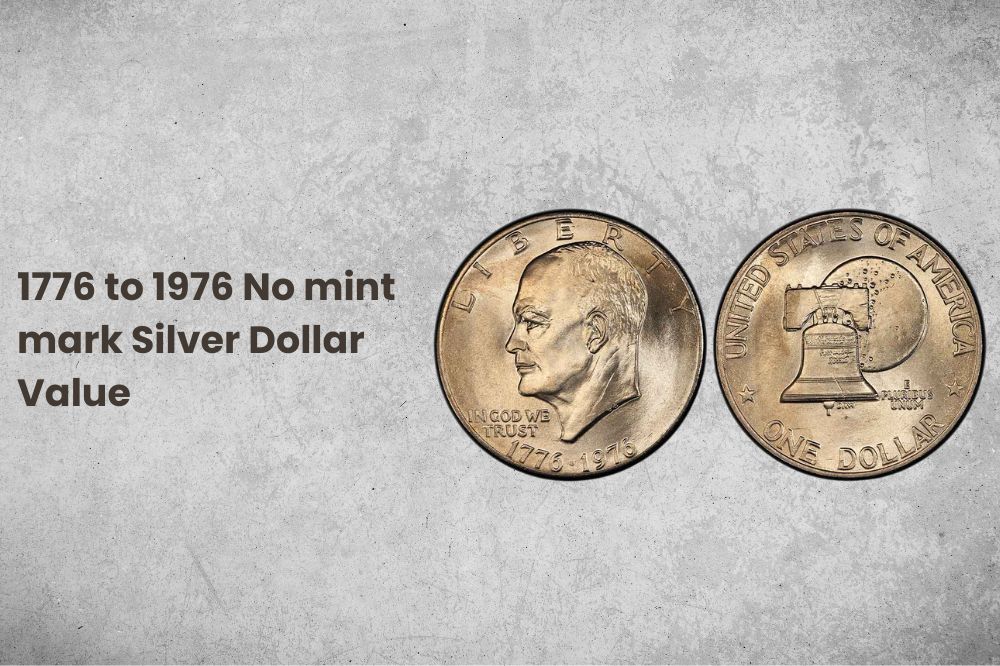
- Type: Eisenhower silver dollar
- Mark Category: Commemorative coin
- Materials: 90% silver, 10% copper
- Edge: Reeded
- Mint Mark: None
- Place of Minting: Philadelphia, Pennsylvania
- Year of Minting: 1975-1976
- Face Value: $1 USD
- Price: Varies depending on condition and other factors, but generally ranges from $10-20 for circulated coins to $25-50 for uncirculated coins.
- Quantity: Approximately 45 million coins were produced.
- Designer: Dennis R. Williams
- Mass: 24.59 grams
- Diameter: 38.1 mm
With over 45 million coins produced in Philadelphia, Pennsylvania between 1975 and 1976, this is one of the most common Silver Dollars out there. Despite its prevalence, its historical significance remains intact as it was created to commemorate the bicentennial anniversary of America’s founding. You can sell a coin in good condition for up to $10 and even get around $50 for one in extremely good value.
Also Read: Top 21 Most Valuable 2000 P Sacagawea Dollar Coin Worth Money
1776 to 1976 D Mint Mark Silver Dollar Value
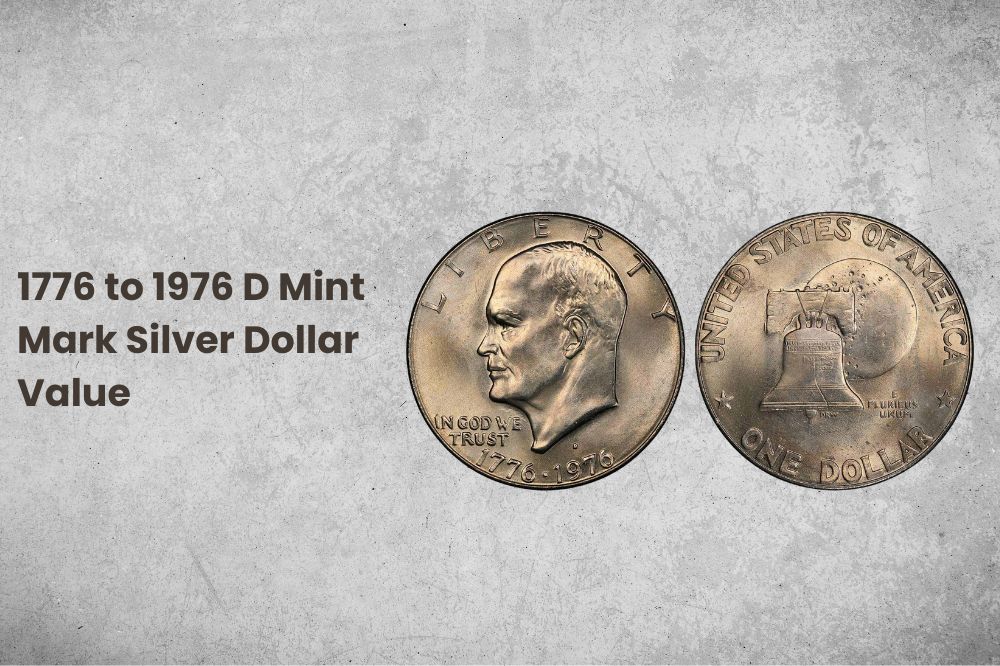
- Type: Eisenhower silver dollar
- Mark Category: Denver Mint mark
- Materials: 40% silver, 60% copper
- Edge: Reeded
- Mint Mark: “D” for Denver
- Place of Minting: Denver, Colorado
- Year of Minting: 1776-1976 (Bicentennial Issue)
- Face Value: $1.00 USD
- Price: Varies depending on condition and rarity, ranging from a few dollars to several hundred dollars.
- Quantity: Approximately 4,908,319 were minted in Denver.
- Designer: Dennis R. Williams
- Mass: 26.73 grams
- Diameter: 38.1 mm
As America celebrated its bicentennial year in 1976, the Denver Mint marked the occasion with a special silver dollar. With just under 5 million coins minted in Denver, this piece is a relatively common, but nice find for any collector. The value of this silver dollar varies depending on its condition and rarity, with some fetching just a few dollars while others sell for several hundred dollars.
Also Read: Top 19 Most Valuable Morgan Dollars Worth Money
1776 to 1976 S Mint Mark Silver Dollar Value
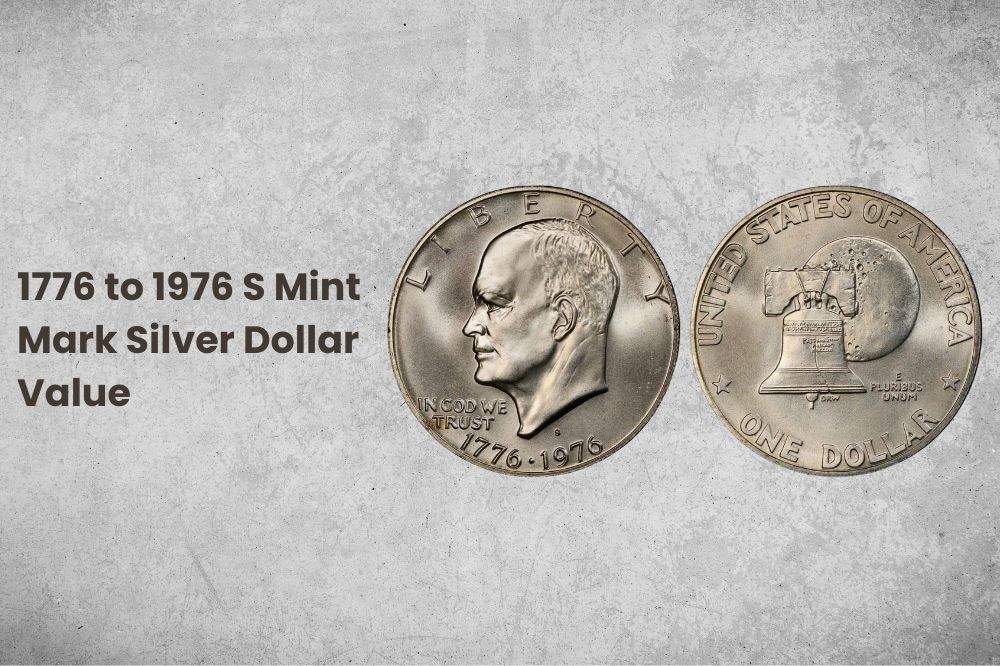
- Type: Eisenhower Silver Dollar
- Mark Category: United States Coins
- Materials: 90% silver, 10% copper
- Edge: Reeded
- Mint Mark: “S” for San Francisco
- Place of Minting: San Francisco, California
- Year of Minting: 1776-1976 (Bicentennial Issue)
- Face Value: $1.00 USD
- Price: Varies depending on condition and rarity, ranging from a few dollars to several hundred dollars.
- Quantity: Approximately 11,000,000 were minted in San Francisco.
- Designer: Dennis R. Williams
- Mass: 26.73 grams
- Diameter: 38.1 mm
The 1776-1976 S Mint Mark Silver Dollar is a real treasure for collectors. Made with 90% silver and 10% copper, this coin contains more silver than any other coin in the series. The price of this coin varies, ranging from a few dollars to several hundred dollars.
1776 to 1976 Proof Silver Dollar Value
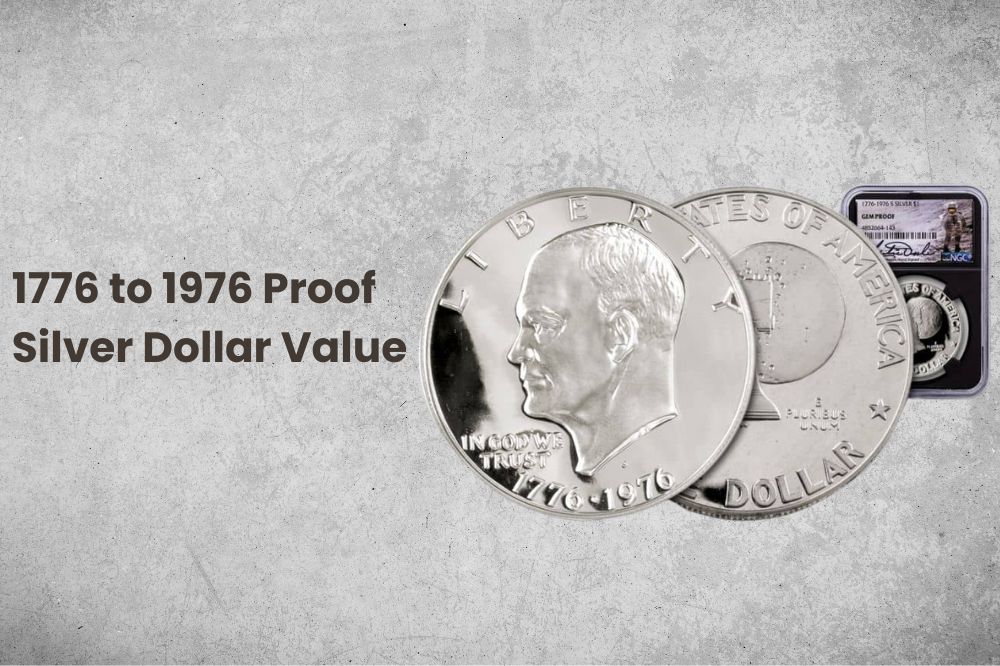
- Type: Proof Eisenhower Silver Dollar
- Materials: 90% silver, 10% copper
- Edge: Reeded
- Place of Minting: San Francisco Mint
- Year of Minting: 1972
- Face Value: $1
- Price: $15 – $25 (Proof-60), $25 – $35 (Proof-63), $35 – $45 (Proof-65), $55 – $75 (Proof-68 or higher)
- Quantity: 1,811,631
- Designer: Frank Gasparro
- Mass: 24.59 grams (0.87 oz)
- Diameter: 38.1 mm (1.5 inches)
The proof edition of the 1776 to 1976 Silver dollar was minted in San Francisco in 1972, and only 1,811,631 pieces were produced. Because of these numbers, it is a nice find for any collector and can sell for up to $75 if it’s in an extremely good state.
1776 to 1976 Silver Dollar History
The 1776 to 1976 silver dollar was issued to mark the United States of America’s 200th anniversary. The currency was designed by Dennis R. Williams, a Chief Engraver at the US Mint after the US Congress recommended it in 1973. The iconic Liberty Bell is superimposed over the moon on the coin’s face, while the reverse displays an eagle gripping an olive branch and arrows, surrounded by thirteen stars to represent the original thirteen colonies.
The introduction of the 1776 to 1976 silver dollar was definitely considered a defining moment in US numismatic history.
It was the first time a US coin was minted to commemorate a specific anniversary, as well as the first time a US coin was struck with a dual date (1776-1976).
The 1776 to 1976 Bicentennial Silver Dollar is constructed of 90% silver and 10% copper, weighing 26.73 grams and measuring 38.1 mm in diameter. It has a face value of $1.00 USD, but its true worth is decided by rarity, condition, and historical relevance. Philadelphia coins bear no mint mark, but Denver and San Francisco coins bear the letters “D” and “S,” respectively.
The Bicentennial Silver Dollar was released as a circulation coin as well as a proof coin. The circulation coins were made available to the general public, whilst the proof coins were manufactured specifically for collectors and sold directly by the United States Mint.
The Bicentennial Silver Dollar was no longer produced after 1976, and the US Mint moved on to other commemorative coin initiatives. The coin’s popularity, however, has persisted over time, and it is still a sought-after collectible item among coin collectors and history buffs.
1776 to 1976 Silver Dollar Grading
Grading a 1776 to 1976 silver dollar (or a Bicentennial Silver Dollar) entails assessing the coin’s general condition, including wear and tear, any damage, and strike quality. Grading allows collectors and dealers to have a better understanding of a coin’s quality and rarity, which can have a substantial impact on its market value.
If you are interested in learning more about the grading process for coins, including how to grade them yourself, you can take a look at this video.
List of 1776 to 1976 Silver Dollar Errors
Despite the precautions used when minting, errors do happen to coins, yet they are still released into circulation. Error coins are appealing to collectors and investors because they are distinctive and typically have a tale to tell.
Following is a list of some typical faults or variants of the silver dollar from 1776 to 1976, along with a brief explanation of each:
Missing Edge Lettering
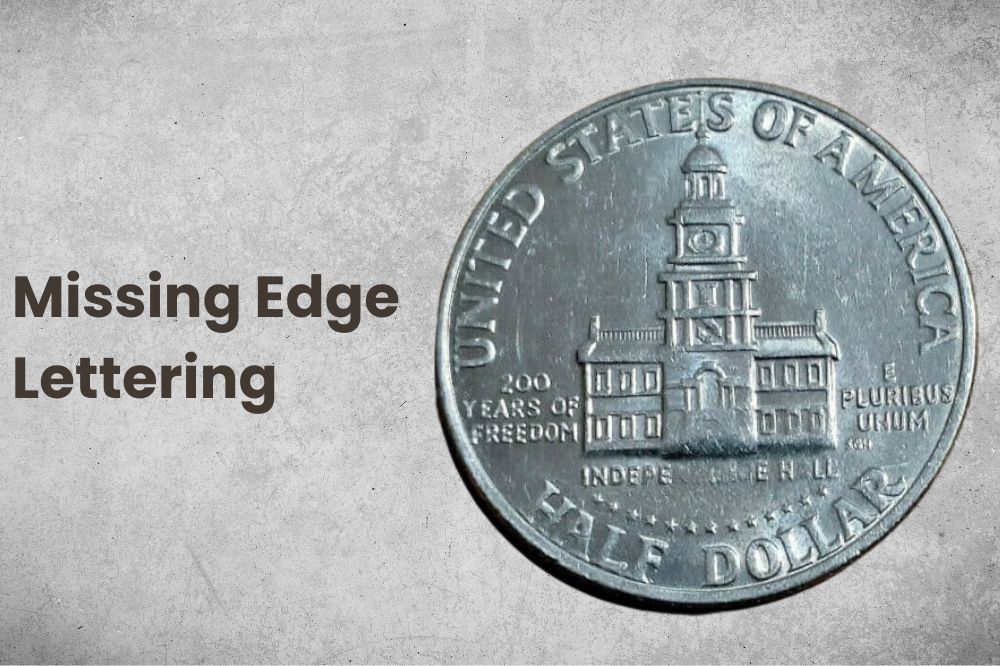
Several silver dollars were minted without the required edge writing “E PLURIBUS UNUM” from 1776 until 1976. This error can occur when the coin blank’s edge lettering dies are not properly aligned with the coin blank during striking. Due to its rarity and distinctiveness, silver dollars with missing edge lettering are often more valuable to collectors, especially if the coin is in uncirculated condition.
Doubled Dies
Doubled die errors happen when a design is slightly off-center on the coin die, causing the design features to appear twofold on the completed coin. An inaccuracy might arise during the die-making process or during the striking process.
The quantity of doubling can vary, and it can have an impact on many sections of the design. Collectors often value coins with dramatically doubled dies more, especially if the coin is in uncirculated condition.
Off Center Strikes
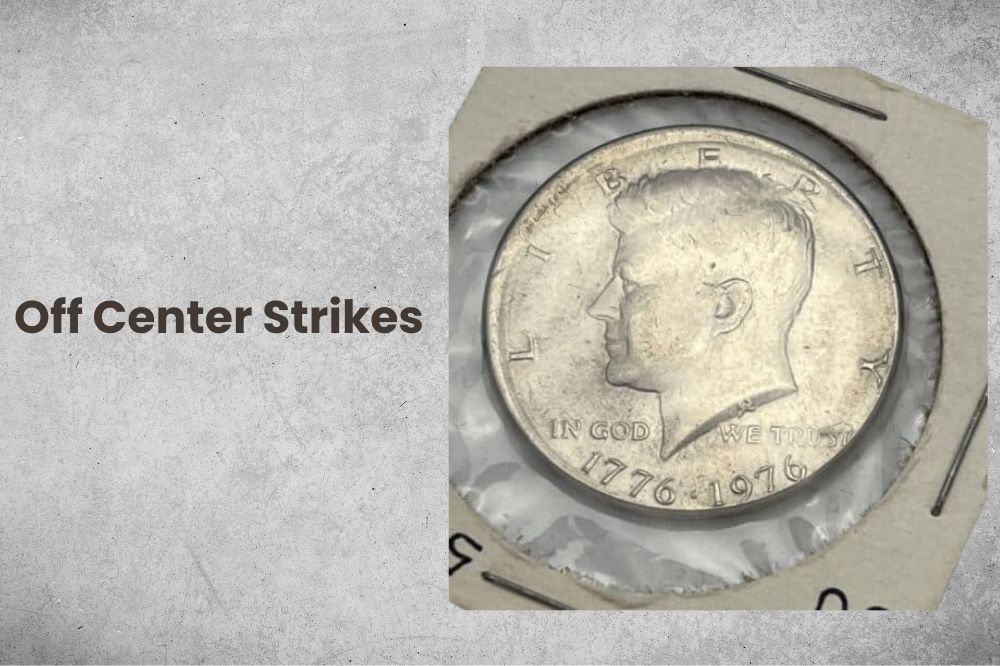
Off-center strikes happen when the coin is not properly aligned with the dies during the striking process, and this causes a partially or entirely missing design on the coin. The degree of off-center strike can range from modest to severe, affecting the position of the elements on the coin.
Struck-Through Errors
Struck-through mistakes will develop when foreign material, such as grease or dirt, gets lodged between the dies and the planchet during the striking process, resulting in deformed design components. Depending on the degree of inaccuracy and the general condition of the coin, these flaws might make the coin more appealing to collectors and boost its value.
Repunched Mint Marks
Repunched mint marks occur when the mint mark is stamped into the die many times, which creates a slightly doubled look. An inaccuracy might happen during the die-making process or during the striking process. The degree of doubling or offset varies, and the inaccuracy might affect various portions of the mint mark.
1776 to 1976 Silver Dollar FAQ
What makes a 1776-1976 Eisenhower Dollar rare?
Errors in the minting process, limited mintage numbers, and high-grade condition are all factors that can make a 1776-1976 Eisenhower Dollar uncommon. The 1976-S silver proof coin, which is made of 40% silver, and the 1976-D Type 2 coin, which boasts a clearer portrayal of the Liberty Bell on the reverse side, are two of the most sought-after versions of the coin. A Denver-clad coin struck on a silver San Francisco planchet sold for $8,000 as one of the most valuable silver dollar coins.
Where is the mint mark on a 1776-1976 D Silver Dollar?
On a 1776-1976 D Silver Dollar, the mint mark is located on the obverse side of the coin, to the right of President Eisenhower’s picture. The “D” mint mark denotes that it was produced in Denver, Colorado.
What is a 1776-1976 Eisenhower Dollar with no mint mark?
A 1776-1976 Eisenhower Dollar with no mint mark was manufactured in Philadelphia, as the mint mark was removed from coins made at this mint in 1975 and 1976. These coins were created to commemorate the bicentennial of the United States and contain a dual date of “1776-1976” on the side.
How much is a 1776-1976 silver quarter worth?
Unless in high-grade uncirculated condition, the 1776-1976 silver quarter, often known as the Bicentennial quarter, is worth face value. The value of an uncirculated coin can range from a few dollars to more than $10, depending on the coin and its condition.
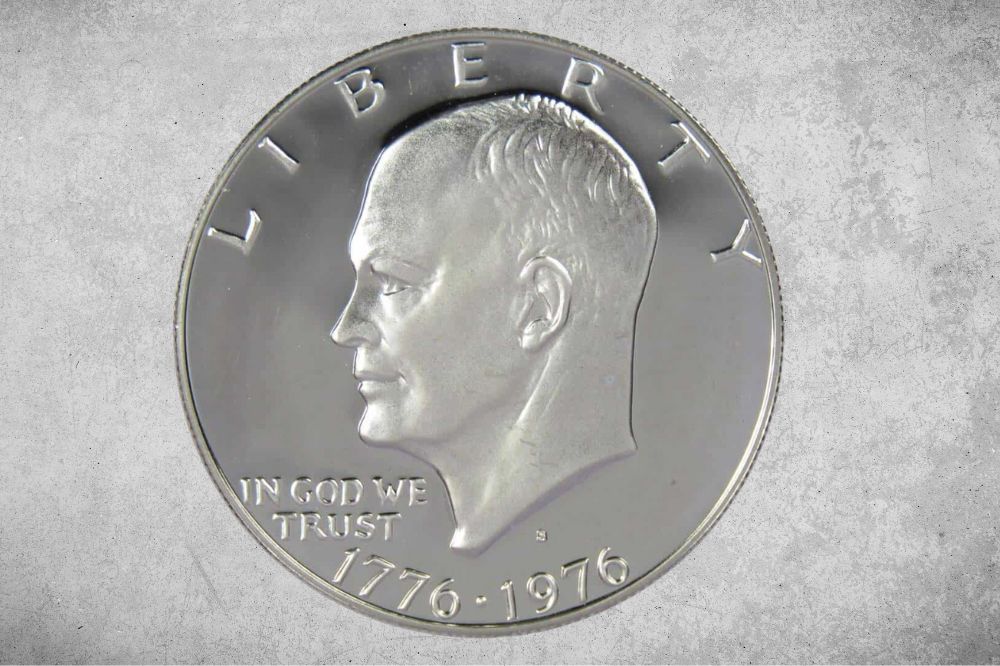
I have a silver one dollar liberty coin the USA in 1776-1976 for sale
How much?
I have 2 one dollar coin 1776 to 1976 type 1 d mint and a type 2 thin letters on the back no mint mark 5205102242 if any one is interested that’s my number
I have fifteen of them for sale. Twelve bicentennial and two 1971 and one 1972 silver dollars
I have fifteen silver dollars for sale 1971-1972-1972 the rest are bicentennial
I have fifteen of them for sale. Twelve bicentennial and two 1971 and one 1972 silver dollars
Silver dollars for sale
I have 14 half dollar 1776_1976 coins
6 one dollar 1776_1976
2 half dollar 1954 y
2 1971 half dollar
2 1972 half dollar
I would like to know if someone is interested in buying them. I really don’t know the value of all of them. I’ve them since 1989_2007 that’s when I got the last one. Thanks a lot
I have 31-32 BC Alexander the Great coin for sell. Best offer.
I have a half moon 1776-1976 bicentennial Eisenhower Denver mint but it’s a blob instead of a d. Interested ? 406 589 1055. Wayne Johnson
I have a Bicentennial 1776-1976 Dollar with 2 error marks for sale
I have 35 bi-centennial Ike’s 3 w/no mints type 1&2 and over 100 coins 71 thru 78 5417070371 make offer on all or part